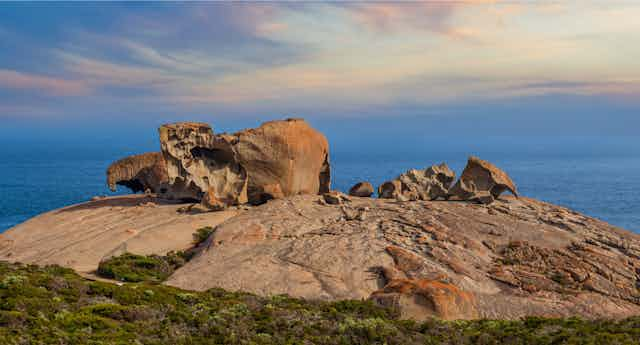

Enjoy them while you can? The ecotourism challenge facing Australia’s favourite islands
Senior Lecturer in Tourism Management, University of South Australia
Disclosure statement
Freya Higgins-Desbiolles is an ordinary member of Kangaroo Island Eco-Action, a non-government organisation supporting environmental conservation on Kangaroo Island.
University of South Australia provides funding as a member of The Conversation AU.
View all partners
I fell for Kangaroo Island from my first visit. I recall standing on a headland on the island’s southern coast, near Remarkable Rocks (a popular tourist site), and being awestruck by the Southern Ocean.
The island (Australia’s third-largest after Tasmania and Melville Island) is one of 16 designated National Landscapes and arguably South Australia’s greatest tourism treasure. Its protected areas (notably Flinders Chase National Park) are home to rare and endangered marsupials and birds.
A year ago, in Australia’s “Black Summer”, bushfires ravaged more than half the island (about 211,000 hectares). Those fires underscored the threat to this and other iconic island destinations.
Both directly and indirectly, humans are endangering these fragile ecosystems through unsustainable development and human-caused climate change.

The most ironic threat is from unsustainable tourism. These islands attract millions of visitors a year keen to experience their natural wonders. Yet often this very “ecotourism” is contributing to their degradation.
How to do better?
Last October I took part in a workshop at which Kangaroo Island’s tourism operators discussed how to do so. 2020 was a difficult year for them, first with the fires, then with the COVID-19 pandemic. But in that adversity they also saw the opportunity to reset “business as usual” and come back better, creating an industry not harming its core asset.
Read more: The end of global travel as we know it: an opportunity for sustainable tourism
A range of ideas came out of our talks applicable to all our island destinations. But there was one key point. Ecotourism should be more than fleeting feel-good experiences. It should not be a “value extraction” but a “values education”, inspiring visitors to go home and live more eco-consciously.
Macquarie island
The paradox of ecotourism is perhaps best exemplified by Australia’s least visited island destination – Macquarie Island, about 1,500 km south-east of Hobart, halfway between New Zealand and the Antarctica.
Just 1,500 tourists a year, rather than hundreds of thousands, are permitted by the Tasmania Parks and Wildlife Service to visit. The island has no hotels, restaurants or souvenir shops. The only buildings are those of the Macquarie Island Station research base and a few isolated field huts for scientists.

Tourists must be content with coming ashore for the day from the 18 small cruise ships that ply these waters in summer. The only hospitality is the traditional station offering of tea and scones .
But what tourists do get is a unique experience. Macquarie is World Heritage listed as the only island made entirely from the earth’s mantle. It also teems with wildlife – multiple species of penguins and seals in their tens of thousands, and birds in their millions.

It’s about as pure an ecotourism experience you can have (if you can afford it). Even so, it still takes resources to get there, including the burning of fossil fuels, contributing to the global warming that is the greatest threat to the environmental integrity of Macquarie Island (and other island ecosystems).
However, the Tasmania Parks and Wildlife Service does at least expect cruise ship operators to “demonstrate their capacity to deliver desirable outcomes” on criteria including minimisation of environmental impacts and communicating to tourists “messages about the natural and cultural values of the island”, including the role they play in its preservation.
Read more: From Kangaroo Island to the Great Barrier Reef, the paradox that is luxury ecotourism
K'gari (Fraser island)
Communicating such messages is something that certainly needs improvement on another World Heritage listed island – K'gari (commonly known as Fraser island), the world’s largest sand island.
About 250 km north of Brisbane, at the southern end of the Great Barrier Reef, the island draws many hundreds of thousands of visitors a year to its beaches, woodlands and rainforests. (There are no recent public statistics on island visitor numbers but in 2017-18 the Fraser Coast region attracted 1,515,000 visitors.)

Once the island’s resources were mined and logged. Tourism was meant to be much less exploitative. But a range of organisations including the International Union for Conservation of Nature have highlighted the pressure tourist numbers (along with their vehicles and infrastructure) are placing on K'gari’s landscapes and wildlife.
Communicating to all those visitors the role they play in the island’s preservation appears to be failing. The bushfires that burnt half the island (about 165,500 hectares) over nine weeks between October and December last year allegedly resulted from an illegal camp fire .

Headline-grabbing attacks by the island’s residents dingos – such as in April 2019 when a toddler was dragged from a campervan – have also been credited to rampant irresponsible tourist behaviour (feeding dingoes to get better photos, for example).
Indigenous elders, conservationists and scientists have all pointed to the problem of a mass-tourism model that doesn’t put enough emphasis on educating visitors about the environment and their responsibilities.
Read more: The K'gari-Fraser Island bushfire is causing catastrophic damage. What can we expect when it's all over?
Rottnest Island
One of our proposals for Kangaroo Island is to reduce the impact of motor vehicles through encouraging more extended walking and cycling experiences.
The value of sustainable transport as the foundation for ecotourism is demonstrated by Rottnest Island, 20 km off the coast of Perth.
The entire island is managed as an A-Class Nature Reserve. Apart from service vehicles and shuttle buses, it is car-free . You can hire a bike or bring your own to get around the island (11 km long and 4.5 km wide). Or simply walk.
The absence of traffic makes a Rottnest holiday a distinctly more relaxed experience. It’s a fair example of slow tourism ; and, of course, it is also good for the island’s world famous quokkas , which co-exist with close to 800,000 visitors a year .

Read more: Before and after: 4 new graphics show the recovery from last summer's bushfire devastation
Before they are gone
Given a little space, nature is resilient.
After Kangaroo Island’s bushfires a year ago, for example, it was feared a number of endangered species had finally been driven to extinction.
But in two of 2020’s few good news stories, scientists found critically endangered Kangaroo Island dunnarts and little pygmy possums – the world’s smallest marsupial – had survived.

But we can’t take that resilience for granted if we keep putting pressure on these fragile ecosystems. We need a better approach to ensure ecotourism isn’t about enjoying these natural wonders before they are gone.
- Kangaroo Island
- Macquarie Island
- Pygmy possum
- Kangaroo Island dunnart
PhD Scholarship

Senior Lecturer, HRM or People Analytics

Senior Research Fellow - Neuromuscular Disorders and Gait Analysis

Centre Director, Transformative Media Technologies

Postdoctoral Research Fellowship

- Standard Resort Hotel Room
- Wallum Resort Hotel Room
- King Resort Hotel Room
- King Bay Resort Hotel Room
- Family Resort Hotel Room
- One Bedroom Villa
- Two Bedroom Villa
- Three Bedroom Villa
- Executive Villa
- Holiday Houses
- Family Fun on K'gari (Fraser Island)
- K'gari (Fraser Island) Romantic Escape
- Seasonal Special Deals
- Illumina Packages
- K'gari (Fraser Island) Packages
- K'gari + Adventure
- K'gari Whale Retreat
- Dune Restaurant
- Sand & Wood Restaurant
- The Sand Bar & Bistro
- Rainforest Bar
- Bush Tucker Talk & Taste
- Beauty Spots 4WD Tour
- K'gari Mult-Day Tours
- Personalised Tours
- Whale Watch Cruise
- Day Away Day Trips
- School Groups Tours
- Island Day Spa
- Ranger-Guided Activities
- Segway PT Adventures
- Junior Eco Rangers
- School Groups Activities
- K'gari (Fraser Island) Meetings
- K'gari (Fraser Island) Weddings
- Nature's Classroom
- Celebrations
- Holiday Happenings
- What's On Guide
- Air Transfers
- Coach & Train
- K'gari (Fraser Island) Ferry
- Sustainable Travel
Our Responsibility
Kingfisher Bay Resort is an award-winning eco resort nestled along the western bay of K'gari (formerly Fraser Island), with a longstanding commitment to providing low impact tourism experiences and helping protect one of our planet's most pristine destinations.
Kingfisher Bay Resort is an established operator with Advanced Ecotourism Certification and Green Travel Leader status from Ecotourism Australia in recognition of our commitment to using resources wisely and creating sustainable practices.
CONSERVATION
If you are committed to saving our environment, we would love to welcome you into our Conservation Program. For Housekeeping to service your room, simply insert the ‘Please Make Up My Room’ sign into your door, prior to 08:00am on the day required. If you don’t require your room to be serviced, don’t insert the ‘Please Make Up My Room’ sign. This initiative minimises carbon emissions associated with washing linen.
K'GARI (FRASER ISLAND) CONSERVATION AND EDUCATION
We have formed and continue to foster long-term community connections, with a shared focus of conserving K'gari (Fraser Island) for future generations, through education initiatives and supporting sustainability programs.
University of Sunshine Coast, Fraser Coast Regional Council and Butchulla Aboriginal Corporation The K’gari Discovery Centre is a cultural endorsement for enhanced environmental awareness and conservation efforts on Fraser Island. Research and decades of historical documents, reports and photographs have formed the first stage of this initiative. This is a joint initiative funded by the University of Sunshine Coast (USC) and Kingfisher Bay Resort, with support from the Butchulla Aboriginal Corporation and Fraser Coast Council. The centre is located at the Kingfisher Bay Resort Village Store Complex.
University of Sunshine Coast Teaming up with the next generation of world changers, USC students and researchers from multiple campuses use our accommodation and resources to get around the island and conduct vital ecological research.
Fraser Island Natural Integrity Alliance FINIA (Fraser Island Natural Integrity Alliance) is a community-based partnership dedicated to protecting Fraser Island (K'gari) World Heritage Area's natural integrity, ecological assets and unique beauty through collaborative management, community education and targeted rehabilitation work. Sealink Kingfisher Bay's long-term support to FINIA and its members has assisted with the delivery of multiple projects and initiatives.
WASTE MANAGEMENT
Kingfisher Bay Resort has a continued focus on reducing waste. With limited services provided by the government on K'gari (Fraser Island), the team at Kingfisher Bay Resort now internally manages all composting and recycling saving 60 tonnes from landfill per quarter.
Reusable Toiletries Single-use plastic toiletries are not available at the resort. Each hotel room and villa is fitted with reusable toiletries to offer this guest amenities. Toiletries include shampoo, conditioner, body wash, moisturiser, hand soap and shaving gel.
Dedicated Recycling Team All waste is collected by our team and taken to our waste management centre for sorting. Recyclables are checked to ensure all items meet processing requirements. Once packaged, items are transported to the mainland for processing.
On-Site Composting Shredded office papers and kitchen preparation scraps are turned into rich compost in the onsite worm farm and then used to grow herbs for the kitchen. This ultimate recycling process has its own interpretive signage you can discover on our Ranger-Guided Eco Walk.
Reducing Paper Consumption Via Apps and Functionality Paperless booking systems and the increased adoption of screens and apps within the resort have provided an opportunity to reduce paper consumption. Our What’s On Guide was previously printed on a weekly basis and can now be found readily on hotel televisions and through the Kingfisher Bay Resort app.
GIVING BACK
As part of our commitment to having a positive social impact, Kingfisher Bay Resort works with and supports a number of charities based in the Fraser Coast and greater regions.
Kingfisher Bay Resort’s longest-standing initiative is supporting local charities for over 20 years through a biannual long lunch event, including a charity auction. Our dedicated team organise and host each event, with our last event raising $14,500 for Hervey Bay Sunrise Rotary Club.
Other Charities we have supported through this initiative, include:
- Hervey Bay Sunrise Rotary Club: $14,550 raised in June 2022
- Forget Me Not Australia Limited: $14,310 in November 2021
- So Brave Young Women's Breast Cancer Charity: raised $17,000 in June 2021
- RACQ LifeFlight: $16,200 raised in November 2020
- Hervey Bay Neighbourhood Centre's Comfort Kitchen
- Variety Australia
- Beyond Blue
This commitment extends to supporting charitable organisations year-round, as Kingfisher Bay Resort also provides prize donations for events and fundraisers to assist with charity auctions, door prizes and recognition for volunteers.
Our team passionately support volunteer services within the Fraser Coast community, volunteering as members of committees and volunteer services that are associated with the preservation of Fraser Island and the health of our valued guests. Several of our team volunteers for the Rural Fire Brigade and firefighting base at Kingfisher Bay Resort.
SUPPORTING LOCAL
Kingfisher Bay Resort supports a full-time continuing undergraduate student enrolled in Bachelor of Business (Tourism, Leisure and Management) at USC Fraser Coast. This support is provided through a bursary aimed to assist with the student's studies and progression in the tourism industry.
We also partner with Australian local businesses to source products and services that contribute to a healthy local economy. Plus, we regularly engage a minimum of 47 local contractors for resort projects.
ARCHITECTURE
Kingfisher Bay Resort was consciously designed and built to integrate with its unique natural environment.
Trees and plants were relocated to an onsite nursery before construction commenced, and later used in landscaping when the resort was complete.
The resort’s main buildings float on 1600 pylons sunk to a depth of 16 metres, which creates a unique system for buildings to shift with the natural sand movements.
Design features such as high curved ceilings in the main resort complex provide for a cool atmosphere, removing the need for air-conditioning, with louvres opened in summer to allow natural cooling.
Kingfisher Bay Resort was the first resort in Australia to employ a Director of Environmental Management from the pre-opening phases. The holder of this position became a founding Director of Ecotourism Australia and engaged with Government and industry to ensure all environmental guidelines were adhered to when constructing the resort.
Our dedicated team continues to focus on enhancing Kingfisher Bay Resort’s sustainable travel experiences. Listed below are goals our team are aiming to achieve.
SINGLE USE PLASTIC FREE
We are aspiring to be single use plastic free at Kingfisher Bay Resort under our dedicated waste management initiative.
Current steps to reach this goal:
- All our takeaway containers and takeaway coffee cups and lids are 100% biodegradable.
- Use of bamboo takeaway cutlery and napkin/bags provided are 100% biodegradable.
- Eliminated single use plastic bags from the Village Store and reusable cloth bags are available for purchase
INCREASED USE OF RENEWABLE ENERGY
Kingfisher Bay Resort is focused on developing renewable energy efficient initiatives, making efforts to move towards renewable energy, including research into a solar farm to offset emissions.

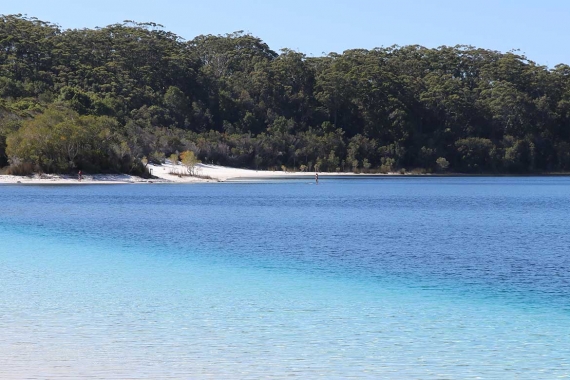
K'gari (Fraser Island)
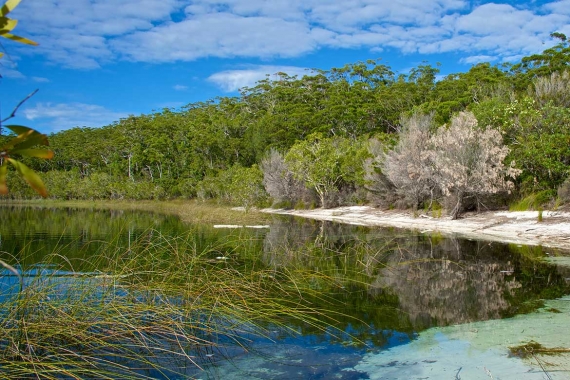
K'gari (Fraser Island) Research
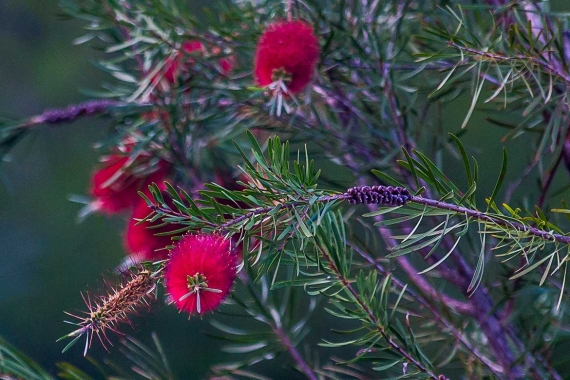
Nature & Ecotourism
SUBSCRIBE TO OUR NEWSLETTER
Upcoming Events
- Spa Special: Relax and unwind with our spa deals.. .
- 22 Jun - 7 Jul: Junior eco rangers winter school holidays program
- Jul - Oct: Holiday with Whales on K'gari (Fraser Island)
- 17 - 18 Aug: Wedding Familiarisation Weekend
- From 30 Sep: Illumina - all-new light and sound spectacle
Our Eco Philosophy
We believe in: "Ecologically sustainable tourism that fosters environmental and cultural understanding, appreciation and conservation" . ... read more
Making News
- Kingfisher Bay Resort Announces Illumina
- SeaLink K’gari Claims Three Prizes at the FCBT Awards 2023
- NPRSR (National Parks) UPDATE: Current conditions, road and track closures, permits, dingo safety and driving in the Great Sandy National Park.
About K'gari (Fraser Island)
Stretching over 123 kilometres along the southern coast of Queensland, K'gari (Fraser Island) is the largest sand island in the world. ... read more
- Things to Do
- Quick Links
- K'gari Magazine
- Resort Info
- Resort Facilities
- Residential Sales
- Media Centre
- Join the Team
- Agents Resources
We use cookies on this website so we can provide you with a better browsing experience and show you more relevant content and promotions. By continuing to use this website, you consent to our use of cookies. For more details, please check our Privacy Policy .

Fraser Island (K'gari) World Heritage integrity
Key finding.
Fraser Island (K’gari) World Heritage Area is sufficiently large, diverse and largely free from disturbance. It contains all the geological, geomorphological, hydrological and ecosystem components required for continued viability.
Fraser Island (K'gari) (information applies statewide, map locations are for reference only)
This property is the Country of the Butchulla Aboriginal people. The name of the island in Butchulla language is K’gari. The World Heritage property includes all of K’gari and several small adjacent islands off the west coast including Stewart and Dream Islands, covering an area of 181,851 hectares.
The boundary of the property extends 500 metres seaward from high water mark around K’gari and the smaller islands.
Most of this World Heritage Area is National Park, located within the Great Sandy National Park (K’gari section).
- All of the marine area is within the Great Sandy Marine Park.
- A small portion of the World Heritage Area occurs on other tenures, including freehold land. Management requirements ensure the World Heritage values are maintained across all tenures.
There is no significant immediate human threat to coastal processes such as longshore drift and other ongoing ecological processes that make this area outstanding.
- The property is sufficiently large, diverse and free from disturbance to contain all ecosystem components required for viable populations of all species and for continued maintenance of all natural phenomena. For example, the development of soil profiles and dune systems remains essentially undisturbed.
- Weeds, plant diseases and feral animals, while present, are in low numbers and subject to active management.
- Disjunct and relict populations of flora and fauna, including those associated with the lakes and creeks, have remained intact and will continue to be important for ongoing speciation.
High visitor numbers and pressures from recreational use and impacts related to climate change, sea level rise, biosecurity and surrounding land use activities will require enhanced and systematic monitoring and increased management focus on World Heritage values to ensure conservation of the property’s values in the long-term.
More information:
- Statement of Outstanding Universal Value
- World heritage list
Relevant Sustainable Development Goals’ targets

Last updated: 03 September 2021
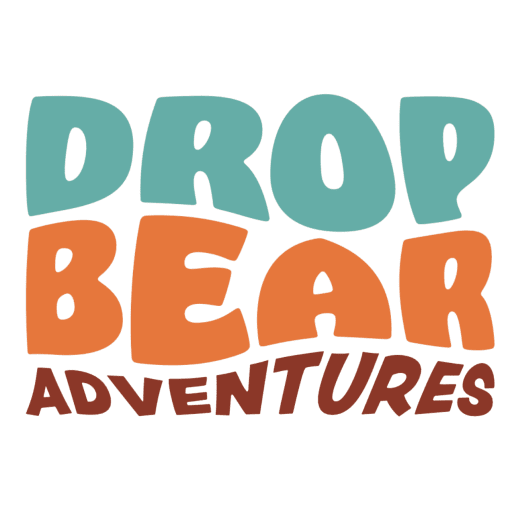
- Our K’gari Tours
- Things To Do in Australia 👇
- New South Wales
- South Australia
- Western Australia
- Northern Territory
- Drop Bears Australia
- Australia Travel Guide
- Van Life Australia
- Fraser Island
- Fraser Island Camping
- Cairns Day Trips
- Sailing Trip Whitsundays
- Great Ocean Road
- Cultural experiences
- What To Do in Brisbane
- What To Do in Sydney
- Best Things To Do in Melbourne
- Travel Australia
- Uluru Travel Packages
- Explore Australia
- Whitsunday Islands Tour
- Best Things To Do Great Ocean Road
- Cairns Tour Packages
- Things To Do in West Coast Australia
- What are Drop Bears?
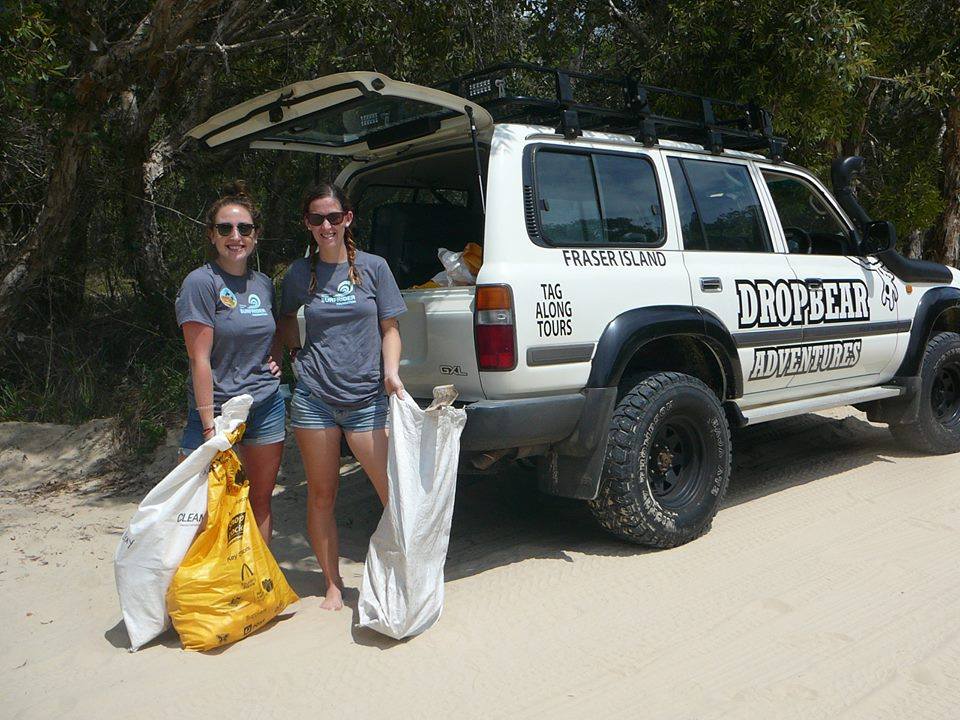
Fascinating Fraser Island
Eco-tourism on fraser island: doing our part to keep k’gari beautiful.
Fraser Island is located in the Great Sandy National Park, its natural beauty protected by Queensland state laws and National Park regulations. Fraser Island is also a World Heritage listed natural wonder, and as such of international significance. Most importantly, to us Fraser Island is the most beautiful place in the world (it’s our favourite backyard paradise, and some of us even call it home).
To us, keeping K’gari beautiful isn’t just a noble cause or a good business strategy, it’s an obligation. We want to share the wonders of Fraser Island with our visitors, make them aware of her fragile beauty, while doing everything we can to minimise the impact our tours have on her ecosystem.
Drop Bear Adventures Tours on Fraser Island have been certified by Ecotourism Australia, whose principles are in line with our beliefs: “Ecotourism is ecologically sustainable tourism with a primary focus on experiencing natural areas that fosters environmental and cultural understanding, appreciation and conservation”.[vc_gallery type=”image_grid” images=”4501,4505,4509,4513,4517,4521,4525,4529″] The things we do to reduce waste and conserve the Fraser Island environment on our eco-tours include:
- camping in designated areas within the National Park
- moving our camp regularly, allow the surrounding vegetation to regenerate
- using sea water to pre-rinse dishes
- sourcing food from local suppliers
- using re-usable food and beverage containers
- minimising and recycling waste
- asking our guests to apply sunscreen well in advance before swimming in the lakes and streams to prevent water pollution
- minimising the amount of luggage transported
Another important aspect of sustainable tourism is cultural sensitivity and an awareness for the history of the original owners of K’gari. Our guides try to convey their respect and regard for that history by using the indigenous names for the island and its places and telling the dreamtime stores associated with them, without masking the dark chapters in the past of this island paradise. Our aim is for all visitors to come away from their Fraser Island tour with an understanding of and respect for this beautiful place and all the people who have lived here or have visited, and to preserve K’gari for all those who will set foot on her sands in future.
- how can we help?
- Things To Do Great Ocean Road
- what is a drop bear?

A Guide to Visiting Fraser Island, The World’s Largest Sand Island

Fraser Island is not the tropical island paradise that you might imagine when picturing the islands off Australia’s Queensland coast. No, you won’t find swinging palm trees here, as Fraser Island is instead home to untamed beaches, ancient forests, dune lakes, shipwrecks and more, making it one of the best adventure experiences that Australia has to offer.
As mentioned in the title of this blog post, Fraser Island is the largest sand island in the world, stretching 122km long. In case you were wondering: yes, a sand island is an island that’s made up of sand. That being said, Fraser isn’t just sand — there’s actually a lot to see!
Fraser Island is one of the “must-dos” on the east coast of Australia travel trail and you’ll find a ton of backpackers camping here. You’ll also find a lot of locals here too, especially those that love 4×4 drives and multi-day camping activities.
If you’re interested in seeing this incredible destination for yourself, here’s my guide to visiting Fraser Island!
Fraser Island’s 4×4 tag-along tours
Many backpackers travelling Australia’s east coast head to Fraser Island for multi-day camping and 4WD adventure packages, which is exactly what we did.
Half the fun of visiting Fraser Island, which lacks sealed roads, is the challenge of driving through the forests and along the beach. This can be intimidating for some, so it’s for this reason that many visitors opt for a 4×4 tag-along tour.
Led by an experienced guide who knows the island well, you’ll cruise the island in a convoy of jeeps, sleep in the national park, and explore the island’s best spots.
But with so many tour operators to choose from, which should you go with?
Drop Bear Adventures: Drop Bear’s signature 3D2N Fraser tour is one of the most popular options — tasty food, reliable 4WDs, beach cabin accommodation and a cracking tour guide to show you around. Book here.
Dingo’s: I personally went with Dingo’s and loved every second of it. The 3D2N tour was led by Jeff, a super knowledgeable, witty and all-around great tour guide. We stayed at a campsite and enjoyed campfire vibes in the evening, after days spent cruising our 4WDs, swimming in lakes, tubing down rivers and more. Book here.
Nomads Fraser Island: Another hugely popular option is Nomads Fraser Island. Book here.
It is possible to visit Fraser Island for one day; there are day tours that offer this. However, I truly feel that it deserves more than that in order to explore everything it has to offer. The most popular tour operators recommend their 3-day, 2-night tours, and I felt that this was an ideal length of time.

Travelling Fraser Island independently
Despite what I said above, it’s totally possible to explore Fraser Island independently without a tour group. This will give you the flexibility of exploring the island at your own pace and will crank up the adventure factor big time.
That being said, travelling Fraser Island independently will require some planning and may work out to be more expensive, unless you’ve got a group of you to split costs. If you’re a solo traveller, joining a 4×4 tag-along tour will definitely be cheaper than going independently.
You’ll absolutely need a 4WD vehicle to get around — if you have your own, great! You can book a ferry transfer for your vehicle and will also need to obtain a vehicle access permit , which costs $52.75, then you’re free to drive around the island at your leisure.
But like most people visiting Fraser Island independently, you’ll probably need to rent a 4WD.
Aussie Trax appears to be the cheapest 4WD rental service. That being said, it’s still far from cheap at $350 per vehicle per day and also has quite bad reviews. If you’re travelling with a group, the price will be reduced, but the cost of the 4WD rental, along with the ferry and accommodation, means that independent travel to Fraser Island is not cheap.
Independent travel to Fraser Island will involve:
- Renting a high clearance 4WD
- Acquiring a vehicle permit
- Booking a return ferry from the mainland to Fraser Island
- Booking accommodation
- Acquiring a camping permit if choosing to camp
Tip: When driving around Fraser Island independently, watch out for the tides. You’ll need to plan your whole trip around them. There are a few spots that can’t be passed during high tide, meaning you may be stuck on one side of the island until the tide goes back out. For instance, Eli Creek joins the sea and gets really deep during high tide. Trying to cross may just ruin your 4WD!
Where to stay on Fraser Island
If you’re heading to Fraser Island on an organised tour, then accommodation will be taken care of for you. Depending on the operator you’ve chosen, you’ll likely be staying in beach hut accommodation or at one of Fraser’s many campgrounds.
If you’re visiting independently, you can choose from a variety of accommodation options. There are a dozen or so hotels available on Fraser Island , which you can book ahead of your stay. These range from the luxurious Kingfisher Bay Resort to small holiday homes and beach huts.
You can also choose to stay in one of the campgrounds on Fraser Island — you can find a list of these here . If you are planning on camping, you’ll need to book camping permits in advance ($6.75 per person per night).
How to get to Fraser Island
Fraser Island is separated from mainland Australia by the Great Sandy Strait and so visitors must get there by ferry.
Hervey Bay and Rainbow Beach are the main launching pads to reach Fraser Island, and you can catch a ferry from either of these locations.
If you’ve booked a Fraser Island 4×4 tag-along tour, you’ll be picked up from Rainbow Beach or Hervey Bay (depending on the tour you’ve booked) and taken to the ferry, so you don’t have to worry about booking/getting the ferry yourself unless told otherwise.
If you’re travelling to Fraser Island independently, you can drive your 4WD to either Rainbow Beach or Hervey Bay to catch the ferry. The choice is yours!
Rainbow Beach: To get to Fraser Island from Rainbow Beach, you can drive to Inskip Peninsula to take a ferry across the channel, which will bring you to the most southern point of the island. Inskip Peninsula is about 14 kilometres from Rainbow Beach.
Hervey Bay: To get to Fraser Island from Hervey Bay, you’ll need to take the ferry from River Heads, which is 20 minutes south of the town. This ferry will drop you off at Kingfisher Resort on Fraser Island.
Things to do on Fraser Island
Drive along 75-mile beach.
As I mentioned before, there aren’t proper roads on the island, only narrow tracks that zigzag through the forest, and a beach that acts as a sort of “highway”. This beach is known as 75-mile Beach, and it stretches along Fraser’s east coast, allowing visitors to navigate up and down the island with ease. I absolutely loved cruising along the beach in our 4WD!

Swim in Lake McKenzie
If you’ve heard of Fraser Island before, then you’ve probably also heard of Lake McKenzie. Situated in the centre of the island, this lake contains water so clear you can see your feet perfectly, and is surrounded by sand so white that you’re almost blinded by it.
The sand here is almost pure silica, so our guide told us we can exfoliate with it, and even wash our hair and teeth with it. I gave this a go, and my hair felt so soft and silky afterwards — you certainly can’t find sand like this in many places around the world.
Lake McKenzie is what’s known as a “perched lake,” which means that it’s filled only by rainwater, rather than being fed by a river.
Lake Wabby + Hammerstone Sandblow
Lake Wabby is a beautiful, green-coloured freshwater lake. It was really quite beautiful but sadly, the lake is situated adjacent to the Hammerstone Sandblow, which is gradually moving into the lake and will eventually completely bury it. Lake Wabby was lovely to swim in, especially as it required a 45-minute hike through the forest to reach it!

Visit the Maheno Shipwreck
The SS Maheno was a 5000-tonne ocean liner that traversed Australia and New Zealand in the early 1900s. At the break of World War I, the Maheno was converted into a hospital ship and carried sick and wounded soldiers before being returned to her owners at the end of the war.
In July 1935, she was sold to a Japanese shipbreaker but never made it to Japan due to a raging cyclone. The ship and crew were helplessly washed onto the shore of Fraser Island, where attempts to refloat her were unsuccessful. She was left abandoned here and remains to this day.
You can freely walk in and around the wreck at your leisure. It’s located on the beach highway and is visible from quite a distance — you can’t miss it!

Go tubing down Eli Creek
Eli Creek is a fantastic spot. There’s a boardwalk that will take you a few hundred metres upstream, from where you can hop into the river and slowly float back down. The tour we went with supplied inner tubes for us to use, but be sure to bring your own if you’re travelling independently! This was possibly my favourite activity we did on Fraser; tubing down a natural lazy river in the sun…

Look out for dingoes and other wildlife
Fraser Island is one of the few places in Australia where it’s possible to see wild dingoes. We saw four or five during our time on the island, all of them along 75-mile Beach.
They’re beautiful animals, native to Australia, and a protected species. Seeing them in their natural habitat is certainly a privilege, and while you shouldn’t be afraid of them, they have been known to be aggressive. Observe from afar, and enjoy watching them run about!
As well as dingoes, you might also spot dolphins and whales frolicking in the ocean. Crocodiles have also been observed in the west of the island.

Take a dip in the Champagne Pools
The ocean surrounding Fraser Island is pretty treacherous – rip tides, undercurrents, stingers and sharks make it too dangerous to swim. However, there is a cluster of rock pools formed by volcanic rock called Champagne Pools which you can visit to swim in the saltwater. The pools are quite a popular swimming hole, where the ocean crashes over the rocks into the pools to provide a beautiful place to swim. We spent a couple of hours swimming here, and found the water to be pretty warm and peaceful.

View the scenery from Indian Head Lookout
Located on the eastern end of 75 Mile Beach sits a coastal headland known as Tuckee, which means ‘stone’ to the Aboriginals who lived on Fraser many years ago. The headland was named ‘Indian Head’ by explorer Captain Cook, who saw aboriginal people assembled here when he passed by.
Indian Head serves as a great vantage point, offering beautiful 360 views of the island to those who climb up to the top. The headland here is also a fantastic place from which to spot wildlife — whales and sharks can sometimes be seen in the ocean below.

Where to next?
- Check out my east coast of Australia road trip itinerary
- Explore tropical Magnetic Island
- Visit the iconic Great Barrier Reef

About The Author
Lauren Pears is a freelance travel writer and blogger based in London. She writes about active adventure travel, aiming to encourage and inspire travellers to make the most of the great outdoors.
Thank you for reading! If you found this post useful, I’d be grateful if you would consider using the affiliate links below when planning your travels. I’ll make a small commission at no extra cost to you. This will help me to keep this blog running. Thanks for your support – Lauren. Hotels – Booking.com Hostels – Hostelworld Cheap flights – Skyscanner Travel insurance – World Nomads Outdoor gear – Decathlon / GO Outdoors Cycling gear – Chain Reaction Cycles Alternatively, you could buy me a coffee to say thanks!

Similar Posts

Noosa Coastal Walk: A Stunning Hike With Fairy Pools, Bays & Wildlife

9 Stunning Hikes on Australia’s East Coast

The Bondi to Coogee Coastal Walk – Everything You Need To Know

The Ultimate East Coast of Australia Road Trip Itinerary

How To Be a Sustainable Tourist at the Great Barrier Reef

Exploring Magnetic Island In A Tropical Topless Car — Where To Go And What To See
Oh my goodness, I am so bummed I missed this when I was in Australia! The water all over looks so clear and gorgeous! I bet it was nice and warm too. I guess I’ll have to go back 😉
Yes you will 😉
I used to camp on Fraser all the time when I was a kid. I really need to go back for a visit.
Ah I’m jealous- you must have gotten to explore so much of the island! There is definitely a lot more of it I’d love to see.
Wow, what an awesome island to 4WD on! I’ve heard so much about it but never actually been. I’d especially love to see the Maheno Shipwreck and go for a swim in that beautiful, blue water!
It really was amazing to drive around the island- a little scary in parts as you needed to have pretty good control of the vehicle but it was a lot of fun!
Leave a Reply Cancel reply
Your email address will not be published. Required fields are marked *
share this!
January 13, 2021
Enjoy them while you can? The ecotourism challenge facing Australia's favorite islands
by Freya Higgins-Desbiolles, The Conversation
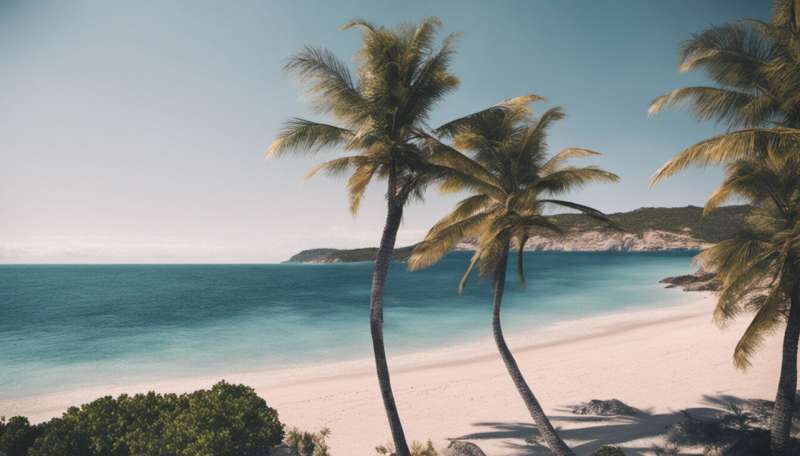
I fell for Kangaroo Island from my first visit. I recall standing on a headland on the island's southern coast, near Remarkable Rocks (a popular tourist site), and being awestruck by the Southern Ocean.
The island (Australia's third-largest after Tasmania and Melville Island) is one of 16 designated National Landscapes and arguably South Australia's greatest tourism treasure. Its protected areas (notably Flinders Chase National Park) are home to rare and endangered marsupials and birds.
A year ago, in Australia's "Black Summer," bushfires ravaged more than half the island (about 211,000 hectares). Those fires underscored the threat to this and other iconic island destinations.
Both directly and indirectly, humans are endangering these fragile ecosystems through unsustainable development and human-caused climate change.
The most ironic threat is from unsustainable tourism. These islands attract millions of visitors a year keen to experience their natural wonders. Yet often this very "ecotourism" is contributing to their degradation.
How to do better?
Last October I took part in a workshop at which Kangaroo Island's tourism operators discussed how to do so. 2020 was a difficult year for them, first with the fires, then with the COVID-19 pandemic. But in that adversity they also saw the opportunity to reset "business as usual" and come back better, creating an industry not harming its core asset.
A range of ideas came out of our talks applicable to all our island destinations. But there was one key point. Ecotourism should be more than fleeting feel-good experiences. It should not be a "value extraction" but a "values education," inspiring visitors to go home and live more eco-consciously.

Macquarie island
The paradox of ecotourism is perhaps best exemplified by Australia's least visited island destination—Macquarie Island, about 1,500 km south-east of Hobart, halfway between New Zealand and the Antarctica.
Just 1,500 tourists a year, rather than hundreds of thousands, are permitted by the Tasmania Parks and Wildlife Service to visit. The island has no hotels, restaurants or souvenir shops. The only buildings are those of the Macquarie Island Station research base and a few isolated field huts for scientists.
Tourists must be content with coming ashore for the day from the 18 small cruise ships that ply these waters in summer. The only hospitality is the traditional station offering of tea and scones .
But what tourists do get is a unique experience. Macquarie is World Heritage listed as the only island made entirely from the earth's mantle. It also teems with wildlife—multiple species of penguins and seals in their tens of thousands, and birds in their millions.
It's about as pure an ecotourism experience you can have (if you can afford it). Even so, it still takes resources to get there, including the burning of fossil fuels, contributing to the global warming that is the greatest threat to the environmental integrity of Macquarie Island (and other island ecosystems).
However, the Tasmania Parks and Wildlife Service does at least expect cruise ship operators to "demonstrate their capacity to deliver desirable outcomes" on criteria including minimisation of environmental impacts and communicating to tourists "messages about the natural and cultural values of the island," including the role they play in its preservation.
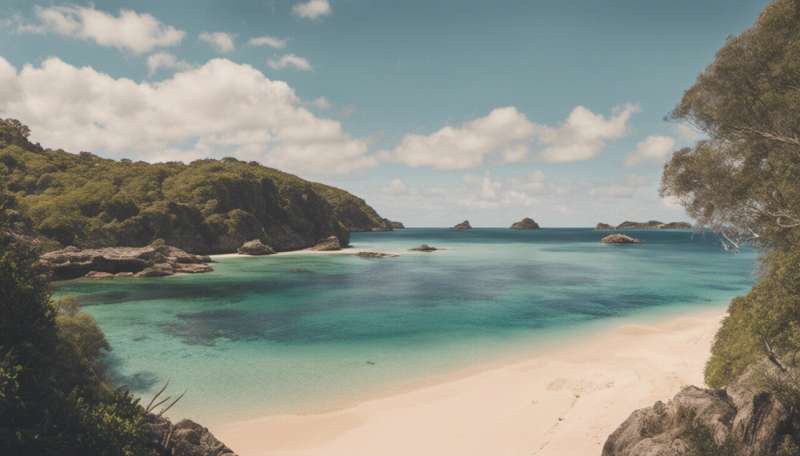
K'gari (Fraser island)
Communicating such messages is something that certainly needs improvement on another World Heritage listed island – K'gari (commonly known as Fraser island), the world's largest sand island.
About 250 km north of Brisbane, at the southern end of the Great Barrier Reef, the island draws many hundreds of thousands of visitors a year to its beaches, woodlands and rainforests. (There are no recent public statistics on island visitor numbers but in 2017-18 the Fraser Coast region attracted 1,515,000 visitors.)
Once the island's resources were mined and logged. Tourism was meant to be much less exploitative. But a range of organizations including the International Union for Conservation of Nature have highlighted the pressure tourist numbers (along with their vehicles and infrastructure) are placing on K'gari's landscapes and wildlife.
Communicating to all those visitors the role they play in the island's preservation appears to be failing. The bushfires that burnt half the island (about 165,500 hectares) over nine weeks between October and December last year allegedly resulted from an illegal camp fire .
Headline-grabbing attacks by the island's residents dingos—such as in April 2019 when a toddler was dragged from a campervan – have also been credited to rampant irresponsible tourist behavior (feeding dingoes to get better photos, for example).
Indigenous elders, conservationists and scientists have all pointed to the problem of a mass-tourism model that doesn't put enough emphasis on educating visitors about the environment and their responsibilities.

Rottnest Island
One of our proposals for Kangaroo Island is to reduce the impact of motor vehicles through encouraging more extended walking and cycling experiences.
The value of sustainable transport as the foundation for ecotourism is demonstrated by Rottnest Island, 20 km off the coast of Perth.
The entire island is managed as an A-Class Nature Reserve. Apart from service vehicles and shuttle buses, it is car-free . You can hire a bike or bring your own to get around the island (11 km long and 4.5 km wide). Or simply walk.
The absence of traffic makes a Rottnest holiday a distinctly more relaxed experience. It's a fair example of slow tourism ; and, of course, it is also good for the island's world famous quokkas , which co-exist with close to 800,000 visitors a year .
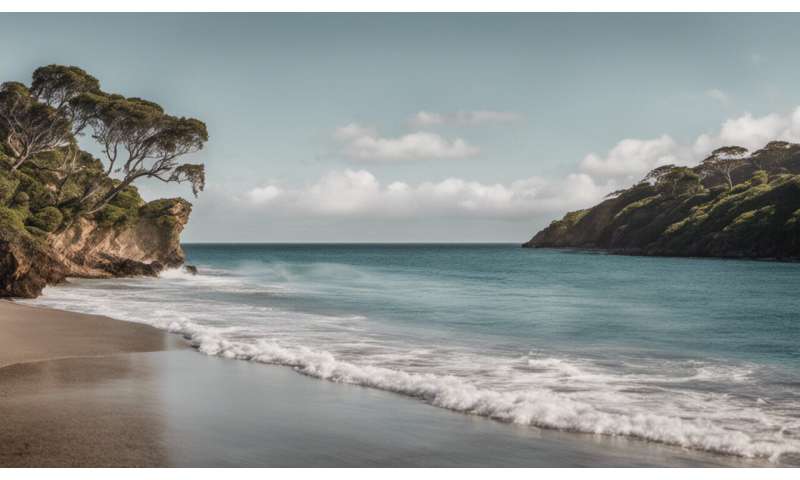
Before they are gone
Given a little space, nature is resilient.
After Kangaroo Island's bushfires a year ago, for example, it was feared a number of endangered species had finally been driven to extinction.
But in two of 2020's few good news stories, scientists found critically endangered Kangaroo Island dunnarts and little pygmy possums – the world's smallest marsupial—had survived.
But we can't take that resilience for granted if we keep putting pressure on these fragile ecosystems. We need a better approach to ensure ecotourism isn't about enjoying these natural wonders before they are gone.
Provided by The Conversation
Explore further
Feedback to editors

The Milky Way's eROSITA bubbles are large and distant
2 hours ago

Saturday Citations: Armadillos are everywhere; Neanderthals still surprising anthropologists; kids are egalitarian

NASA astronauts will stay at the space station longer for more troubleshooting of Boeing capsule
6 hours ago


The beginnings of fashion: Paleolithic eyed needles and the evolution of dress
21 hours ago

Analysis of NASA InSight data suggests Mars hit by meteoroids more often than thought

New computational microscopy technique provides more direct route to crisp images

A harmless asteroid will whiz past Earth Saturday. Here's how to spot it
22 hours ago

Tiny bright objects discovered at dawn of universe baffle scientists
23 hours ago

New method for generating monochromatic light in storage rings

Soft, stretchy electrode simulates touch sensations using electrical signals
Relevant physicsforums posts, who chooses official designations for individual dolphins, such as fb15, f153, f286.
Jun 26, 2024
Color Recognition: What we see vs animals with a larger color range
Jun 25, 2024
Innovative ideas and technologies to help folks with disabilities
Jun 24, 2024
Is meat broth really nutritious?
Covid virus lives longer with higher co2 in the air.
Jun 22, 2024
Periodical Cicada Life Cycle
Jun 21, 2024
More from Biology and Medical
Related Stories

Storms help Australia contain UNESCO heritage island fire
Dec 14, 2020

Australia bush fire rips through heritage-listed island
Nov 30, 2020

Australia orders urgent review after spate of dingo attacks
Apr 21, 2019

The K'gari-Fraser Island bushfire is causing catastrophic damage. What can we expect when it's all over?
Dec 8, 2020

Learning lessons from bushfires for koala survival
Oct 12, 2020

Race to save animals on Australia's fire-ravaged 'Galapagos'
Jan 16, 2020
Recommended for you

Do vertebrate populations really decline so much? Calculations indicating severe declines might be wrong, says study
Jun 27, 2024

Under pressure: How comb jellies have adapted to life at the bottom of the ocean

Predicting chronic wasting disease in counties could prevent spread

Three new extinct walnut species discovered in high Arctic mummified forest

Unlocking biodiversity insights from the tropical Andes

Study projects loss of brown macroalgae and seagrasses with global environmental change
Let us know if there is a problem with our content.
Use this form if you have come across a typo, inaccuracy or would like to send an edit request for the content on this page. For general inquiries, please use our contact form . For general feedback, use the public comments section below (please adhere to guidelines ).
Please select the most appropriate category to facilitate processing of your request
Thank you for taking time to provide your feedback to the editors.
Your feedback is important to us. However, we do not guarantee individual replies due to the high volume of messages.
E-mail the story
Your email address is used only to let the recipient know who sent the email. Neither your address nor the recipient's address will be used for any other purpose. The information you enter will appear in your e-mail message and is not retained by Phys.org in any form.
Newsletter sign up
Get weekly and/or daily updates delivered to your inbox. You can unsubscribe at any time and we'll never share your details to third parties.
More information Privacy policy
Donate and enjoy an ad-free experience
We keep our content available to everyone. Consider supporting Science X's mission by getting a premium account.
E-mail newsletter

travel sustainably
“travel is the only thing you buy that makes you richer”, – anonymous, why travel sustainably.
We love travel! From the excitement of exploring and discovering something new, the friends we could meet along the way, the new experiences it allows us to have and the lifetime memories it creates, travel is something we feel everyone should experience!
It’s important then we understand how our travel choices impact on the destinations we visit to ensure we contribute positively to those regions and thus ensure they can be enjoyed by travellers into the future.
How can I be a conscious traveller?
Being a ‘green traveller’ doesn’t need to be difficult. There are some simple steps you can take to keep your holiday’s impacts as light as possible.
Choose an eco-conscious provider. When researching your holiday, look for providers that mention how they reduce and manage their environmental impacts. EcoTourism Australia have made it easy with their Green Travel Guide
Choose to use public transport when exploring if you can. It’s usually cheaper than renting a car or hiring an uber and it’s also a great way to experience the region like a local. You may even meet some on board and get some locals tips on what to visit! The Sunshine Coast has a great bus network and Con-X-ions can offer airport transfers.
Choose to offset your travel emissions. Many companies provide the option to offset your carbon emissions for an additional small cost, the proceeds of which go into programs which help reduce carbon dioxide in the atmosphere.
Staying in a hotel? Consider whether you need new towels and linen every day. Reducing this can equate to huge savings in water use and carbon emissions.
Be conscious of single-use items such as plastics and disposables when eating and drinking. Instead of choosing takeaway, which often means a lot of plastic and disposables, why not sit in and enjoy; you’re on holidays after all! Love a caffeine hit during the day? Pop a keep-cup in your day bag, there are even some great collapsible styles if you’re light on space. Instead of buying water bottles, carry a refillable one. The Sunshine Coast has numerous filling stations where you can top up your bottle through the day. Ask yourself, do I need a straw? Collectively, these small choices add up to make a huge difference. Plastic Free Noosa can help you find an eco-friendly provider too.
Be mindful of pollutants. Did you know sunscreen needs around 15 minutes to be fully absorbed by your skin? Before this, the excess can wash off and enter the waterways when swimming. Allowing time for the sunscreen to absorb not only helps protect your skin, but it also helps protect waterways, such as Lake McKenzie, from becoming contaminated.
Try visiting the local farmers market. You’ll get a taste of life as a local, be able to pick up some fruit and get to try produce from the surrounding region. Noosa has a great farmers market on Sunday mornings.
How does Discovery Fraser Island manage and minimise its impacts?
We believe in a healthy and sustainable tourism industry and recognise that the decisions we make now will carve our path into the future.
We strive to provide meals and snacks on our tours that produce minimal waste and avoid using plastic wherever possible.
Carbon emissions tracking on all our business vehicles.
Ongoing review of business practices to ensure we are continually improving and adopting the best practices currently available.
K’Gari Discovery Adventures is committed to keeping the island pristine. All rubbish from the tour will be kept in the touring vehicle and removed from K’Gari upon our return to Rainbow Beach. We will provide separate bins for recyclable products and general waste.
We recognize that many of our passengers think like us and want a World Heritage-listed destination to remain beautiful for generations to come. Discovery K’Gari Adventures has recently committed to providing a third bin, which will be used to collect rubbish and debris found on the beach and walking trails. You may encounter some debris or rubbish during one of the many short walks. We encourage you to collect this rubbish, carry it with you until you return to the vehicle and place it in our bin. We can all make a difference!

The Unique Eco-system of Fraser Island
Written by: Cameron Ward
Published: 08/08/2017
Reading time: 3 mins
Situated off the coastline of Queensland, Fraser Island unfolds in a unique eco-system filled with sand dunes, lakes, and sea views.
It is the largest sand island in the world, sprawling out for 120km along its coastline.
The eco-system is like nowhere else in the world, combining an eclectic mix of landscapes each filled with their own characteristics and sights. As well as half of the world’s perched lakes, Fraser Island is also a World Heritage listed site, providing the perfect backdrop for exploring.
The Different Eco-Systems on Fraser Island
The island itself brings together rainforests , wallum forests, coastlines, beaches , freshwater lakes, and sand dunes, providing a constantly-changing backdrop for visitors. Rainforests
The rainforests on Fraser Island are incredibly dense and humid, and are home to an abundance of plant and animal species . Expect to see fungi, liverworts, saplings, mosses, ferns, and lichens basking in the cool air beneath the thick canopies overhead.
Wallum Forests
Freshwater lakes.
Despite it being just an island, there are over one hundred freshwater lakes on Fraser Island, and they are made up of three varieties: perched, window, and barrage.
Fraser Island really is a sight to behold with all of its different eco-systems. There’s a little something for everyone, from rainforests and lakes, to forests and sand dunes.

Cameron Ward turned his travel passion into a thriving Australian tourism business. Before he co-founded his own business, Sightseeing Tours Australia, he was enjoying being a Melbourne tour guide. Even now, Cameron delights in helping visitors from all around the world get the most out of their incredible Australian trip. You’ll see Cameron leading tours or writing about his favourite Australian places where he shares his local insights.
Explore Our Fraser Island Tours
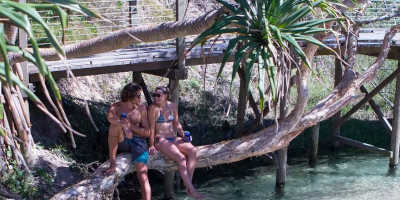
1 Day Fraser Island (K’gari) Tour Departing Hervey Bay from $273
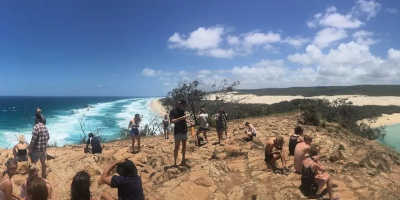
2 Day Fraser Island (K’gari) Tour Departing Hervey Bay $699
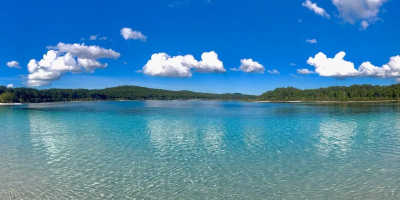
1 Day Fraser Island (K’gari) Tour $190
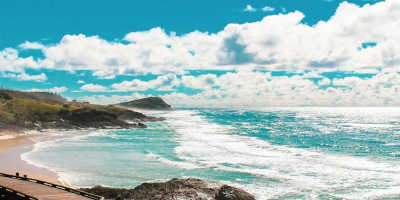
2 Day Fraser Island (K’gari) Tour Departing Rainbow Beach $699
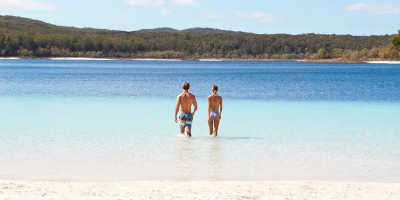
1 Day Fraser Island (K’gari) Tour Departing Rainbow Beach from $273

3 Day Fraser Island (K’gari) 4WD Tag-Along Adventure $549
A first-timer’s guide to visiting Australia’s Fraser Island

Aug 4, 2020 • 7 min read

The Ss Maheno is one of the island's top sights. ©Odair Faléco/500px
There’s something quite magical about first stepping foot on Fraser Island . Stretching over 120km, this raw, rugged sand island – the world’s largest – off Queensland’s southeast coast feels utterly otherworldly.
With its wild untamed beaches, towering old-growth forests, crystal-clear freshwater lakes, and bountiful wildlife including Fraser’s most famous resident, the dingo, this Unesco-listed island offers one of Australia’s best wilderness adventures. It's currently open to visitors (as of August 2020) but there may be some restrictions on interstate travel. Please check local restrictions before booking a trip and always follow government advice.
Half the fun of visiting Fraser Island, which lacks sealed roads, is the challenge of driving in the national park. It’s for this reason that many visitors opt for an organised tour from the mainland. Travelling here independently, however, gives you the flexibility to explore the breathtaking island at your own pace, and cranks up the adventure factor big time.

There are two ways to access Fraser, located about 300km north of Brisbane . Most visitors take the Manta Ray barge that runs continuously between Inskip Point (which has a picturesque beachfront campground) and Fraser’s southern tip from 6am to 5.15pm daily. The 10-minute journey costs AU$130 return (per car) as of August 2020. Booking ahead is recommended.
The other option - aside from landing on the beach in a tiny Air Fraser Island plane - is Fraser Island Barges which runs less frequent daily services from River Heads (20 minutes south of Hervey Bay ) to Wanggoolba Creek and Kingfisher Bay Resort on the west side of the island (both services from $180 return per car; about 50 minutes journey time).
What you need for driving on Fraser Island
Driving anything other than a 4WD with low-range capacity and high clearance onto Fraser is strongly discouraged. This isn’t to say you can’t take your SUV, but the likelihood of damaging the underside of your vehicle on the island’s bumpy roads or getting bogged in sand is much greater, especially if you don’t have much experience driving on sand. If your insurer doesn’t cover off-road driving, you’ll face a hefty bill to have your car towed off the island.
If you don't have your own wheels, there are also several companies in Hervey Bay that specialise in renting 4WD vehicles for touring Fraser. Rental companies can often organise necessary vehicle permits through the Queensland National Parks office for you, and help with ferry and campsite bookings.

What to pack for Fraser Island
There are several supply shops on Fraser’s east coast – at the main settlement of Eurong (which also has a bakery and a pub), Happy Valley, Cathedrals and Orchid Beach, all of which sell fuel, ice and basic supplies – but it’s advised to bring everything you’ll need for the duration of your visit, including water (for drinking and washing), medical supplies (there’s no doctor on the island), AU$2 coins for coin-operated showers available at some campgrounds, and extra fuel.
Distances between attractions might not look far on the map, but it is a slow, fuel-guzzling process navigating Fraser’s roads.
Campfires are only permitted in a select few campsites (outside of 'total fire ban' periods of course), so you’ll need to bring a suitable stove for cooking. Some campsites have refuse bins, but as the island lacks a recycling system, so plan to take your rubbish out with you. Personal portable toilets are a requirement at Coolooloi Creek and Cornwells group camping area, and are recommended for other camping areas without facilities. If you get caught out, bury your business in a deep hole.

For your car:
An air pressure gauge is essential to deflate your tyres for sand driving (check the requirements for your car in advance). No matter what kind of vehicle you’re driving, it’s worth investing in or renting recovery gear including recovery tracks, a shovel, and a snatch strap. Get your hands on a good map and ideally a GPS, as mobile phone reception is non-existent in some areas.
Before you set off, be sure to check the car’s oil and water levels. Also consider bringing a ‘mechanical first aid kit’ including radiator coolant, a spanner set, gaffer tape, a can of WD40, jumper leads, zip ties and a spare fan belt.
Where to camp on Fraser Island
The island has a handful of hotels and guesthouses (centred in Eurong and Happy Valley, and there’s also Kingfisher Bay Resort on the west coast), but many would argue camping is an essential part of the Fraser experience. There are 45 camping areas across the island with varying facilities. For those with small children (under 12) opt for one of the five campgrounds with dingo deterrent fences. Arguably the most picturesque is Central Station . As the name implies, the leafy camp is roughly in the centre of the island, and makes a good base for exploring inland lakes, as well as the Valley of the Giants .

As it’s not possible to drive on the island’s boggy west coast, most seaside campsites are located along the east coast. In the island’s northeast, Waddy Point is a crowd favourite. Sheltered from south-easterly winds, it’s one of the few campsites where fires are permitted.
You’ll need to book camping permits in advance (AU$6.75 per person per night); in peak periods, it’s also worth pre-booking spots at preferred campgrounds.
Dingo safety
Spotting Fraser’s iconic wild canines is a memorable experience, but dingo safety is paramount. While the sandy-coloured canines generally steer clear of humans, there have been attacks on Fraser, some of them fatal. Follow these tips to stay safe, while helping to keep Fraser’s dingoes wild.
- Ensure food is never left unsecured (lock it in your vehicle) and never feed dingoes. Fines apply for both offences. - Don’t leave anything lying around an unfenced campsite that dingoes can chew though or tear at – even toiletries left in a tent can attract. - Clean up straight after cooking and eating, and pour washing up water into a deep hole away from your camp if washing facilities aren’t available. - Always keep small children, which can excite dingo attention, at arms reach. Running can have the same effect, so be sure to walk everywhere. - If you’re threatened by a dingo, stand still and fold your arms across your chest. Face the dingo, then calmly back away (if you are with another person, stand back-to-back). Call for help, but wait until the dingo is gone before you continue on your way. Never run or wave your arms. In an emergency, call 000 or 112.

What to see and do on Fraser Island
Most visitors spend their days exploring the island by 4WD, either returning to the same campsite each night, or moving around every couple of nights. Unmissable activities include taking a dip in the vivid blue Lake McKenzie, and floating down turquoise Eli Creek. Just north of the creek lies popular photo stops including the wreck of the SS Maheno , and the coloured sand cliffs known as the Pinnacles .
If time allows, schedule a hike to Lake Wabby (a 4.8km round-trip from the east coast), and enjoy the pretty inland drive to peaceful Lake Birrabeen. Near Waddy Point, the rockpools known as the Champagne Pools are a safe spot for a saltwater dip. Ocean swimming is generally not recommended on Fraser due to treacherous sea conditions and shark activity – from Indian Head, a bluff just south of the pools, you can often spot sharks patrolling below. If you make it as far as Fraser’s northeastern tip, don’t miss the heritage Sandy Cape Lighthouse .
You might also like:
The 10 best island destinations in Australia Why Tasmania is perfect for ecotourists What travel looks like in Australia in 2020
This article was first published June 2017, last updated August 2020.
This article was first published Jun 12, 2017 and updated Aug 4, 2020.
Explore related stories

Jun 19, 2024 • 8 min read
With an immense shoreline and many rivers, Australia is a playground for kayaking, canoeing, surf-ski and whitewater. Here are its best paddling spots.

May 29, 2024 • 8 min read

May 21, 2024 • 5 min read

Mar 4, 2024 • 8 min read

Feb 27, 2024 • 6 min read

Feb 12, 2024 • 10 min read

Jan 5, 2024 • 20 min read

Dec 27, 2023 • 8 min read

Nov 10, 2023 • 8 min read

Nov 5, 2023 • 16 min read

COMMENTS
Tourism — 7. The impact of 4WDs and roads is inseparable from tourism. The impact of tourism is currently very high because for every single person visit to Fraser Island an average of about one tonne of sand is churned up and when there is heavy rain this loosened sand mobilizes and washes down the slopes and in some places into the lakes.
Key Finding. Increased tourism in the Fraser Island (K'gari) World Heritage Area is acting as a driver for a number of threats. Fraser Island (K'gari) (information applies statewide, map locations are for reference only) Increasing tourist numbers and associated vehicles and infrastructure impacts, while localised, can be intensive around ...
World Heritage partnerships for conservation. Ensuring that World Heritage sites sustain their outstanding universal value is an increasingly challenging mission in today's complex world, where sites are vulnerable to the effects of uncontrolled urban development, unsustainable tourism practices, neglect, natural calamities, pollution, political instability, and conflict.
Kangaroos in burnt bushland on Kangaroo Island, South Australia. RSPCA SA/AAP. The most ironic threat is from unsustainable tourism. These islands attract millions of visitors a year keen to ...
It is clear that Fraser Island is suffering from an unsustainable volume of visitors while the current management policies and technology are applied. The degradation will continue as long as tourism remains unsustainable or unsustainably managed. The Options: Fraser Island World Heritage values will be preserved only if:
1.1. Study Requirements. The aim of the K'gari SVCM study is to assess current site profiles, demand, impacts, and inform future management decisions and tourism/visitor strategies and demonstrate an achievable and sustainable outcome for the area.
World Heritage partnerships for conservation. Ensuring that World Heritage sites sustain their outstanding universal value is an increasingly challenging mission in today's complex world, where sites are vulnerable to the effects of uncontrolled urban development, unsustainable tourism practices, neglect, natural calamities, pollution, political instability, and conflict.
Positive Benefits. The positive benefits of tourism to Fraser Island are manifold and widely extolled and promoted as araison d'etre for continued growth of tourism by those who are the main beneficiaries:. Economic benefits are widely recognized.Fraser Island is conservatively estimated to be worth more than $250,000,000 to the Queensland economy when it takes into account the many spin ...
Our dedicated team organise and host each event, with our last event raising $14,500 for Hervey Bay Sunrise Rotary Club. Other Charities we have supported through this initiative, include: Hervey Bay Sunrise Rotary Club: $14,550 raised in June 2022. Forget Me Not Australia Limited: $14,310 in November 2021.
2021. 44COM 8B.1 - Changes to names of properties inscribed on the World Heritage List. 2012. 36COM 8E - Adoption of retrospective Statements of Outstanding Universal Value. 2001. 25COM VIII - Reports on SOC of natural properties inscribed noted by the Committee. 2000. 24BUR IVB.25 - Fraser Island (Australia) 1992.
This property is the Country of the Butchulla Aboriginal people. The name of the island in Butchulla language is K'gari. The World Heritage property includes all of K'gari and several small adjacent islands off the west coast including Stewart and Dream Islands, covering an area of 181,851 hectares. The boundary of the property extends 500 ...
Drop Bear Adventures Tours on Fraser Island have been certified by Ecotourism Australia, whose principles are in line with our beliefs: "Ecotourism is ecologically sustainable tourism with a primary focus on experiencing natural areas that fosters environmental and cultural understanding, appreciation and conservation". [vc_gallery type ...
No, you won't find swinging palm trees here, as Fraser Island is instead home to untamed beaches, ancient forests, dune lakes, shipwrecks and more, making it one of the best adventure experiences that Australia has to offer. As mentioned in the title of this blog post, Fraser Island is the largest sand island in the world, stretching 122km long.
The paradox of ecotourism is perhaps best exemplified by Australia's least visited island destination—Macquarie Island, about 1,500 km south-east of Hobart, halfway between New Zealand and the ...
The Case Fraser Island Light Rail Feasibility Study First drafted in 2004 and updated February 2015. Transportation on Fraser Island has long been a concern for FIDO. The increasing size of the buses has led to widening of the roads. This has led to loss of canopy, desiccation, and erosion in heavy rainfall events. ... This is unsustainable and ...
Contact Us Phone +61 7 4331 5508 Email [email protected] Office Hours 9am-8pm, Monday - Friday Quick Links K'gari (Fraser Island) Day Tour. Private Group Charters Sustainable Travel
Sand Dunes. Sand dunes are a large part of the eco-system of Fraser Island, and can rise up more than 200 metres above the sea. The most impressive dune on the island is Flinders Sand Blow, which has evolved and moved over thousands of years. Fraser Island really is a sight to behold with all of its different eco-systems.
There are two ways to access Fraser, located about 300km north of Brisbane. Most visitors take the Manta Ray barge that runs continuously between Inskip Point (which has a picturesque beachfront campground) and Fraser's southern tip from 6am to 5.15pm daily. The 10-minute journey costs AU$130 return (per car) as of August 2020.
World Heritage partnerships for conservation. Ensuring that World Heritage sites sustain their outstanding universal value is an increasingly challenging mission in today's complex world, where sites are vulnerable to the effects of uncontrolled urban development, unsustainable tourism practices, neglect, natural calamities, pollution, political instability, and conflict.
The K'gari (Fraser) explorer tours will take you across Fraser Island's top spots, allowing you to experience everything that makes this idyllic location so special. Navigate the island's many 4WD tracks on an off-roading expedition, cruise along 75 Mile Beach to the historic Maheno Shipwreck, and take a dip in Lake McKenzie and the ...
Welcome to our backyard, Queensland's Fraser Coast. It's the home of World Heritage-listed natural gems, unique diving experiences, safe and secluded beaches, the number one place to watch humpback whales play and extensive military history. Whether you are looking to explore the world's largest sand island, K'gari (pronounced 'GAH-ree ...
Fraser Island's Loss of Wilderness. Since Judith Wright's first visit, Fraser Island's wilderness values have been progressively eroded away. Better facilities have been provided for visitation. This has led to exponentially greater visitation and a loss of remoteness from civilization. It has also meant that the sense of isolation has ...
Positive Benefits. The positive benefits of tourism to Fraser Island are manifold and widely extolled and promoted as a raison d'etre for continued growth of tourism by those who are the main beneficiaries:. Economic benefits are widely recognized. Fraser Island is conservatively estimated to be worth more than $250,000,000 to the Queensland economy when it takes into account the many spin ...